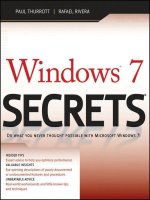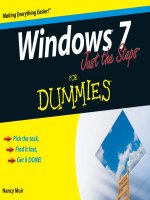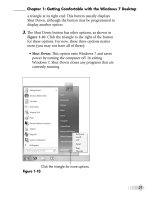Tài liệu Windows 7 Just the Steps for Dummles P2 docx
Bạn đang xem bản rút gọn của tài liệu. Xem và tải ngay bản đầy đủ của tài liệu tại đây (870.62 KB, 20 trang )
➟
23
Remove an Application
Figure 2-13: The Uninstall or Change a Program window
Figure 2-14: The removal confirmation dialog box
If you used some earlier versions of Windows, note that the Add a
Program command is gone. Because all software created today allows
you to put a CD/DVD into your drive or download it from the Internet
and then follow onscreen directions to install the program, Microsoft
must have decided that its own Add a Program feature was obsolete!
Remove an Application
1.
Choose Start➪Control Panel➪Uninstall a Program
(under the Programs category).
2.
In the resulting Uninstall or Change a Program window,
as shown in Figure 2-13, click a program and then click
the Uninstall (or sometimes this is labeled Uninstall/
Change) button. Although some programs will display
their own uninstall screen, in most cases, a confirma-
tion dialog box appears (see Figure 2-14).
3.
If you’re sure that you want to remove the program,
click Yes in the confirmation dialog box. A dialog box
shows the progress of the procedure; it disappears when
the program has been removed.
4.
Click the Close button to close the Uninstall or Change
a Program window.
With some programs that include multiple applications, such as
Microsoft Office, you get both an Uninstall and a Change option in
Step 2. That’s because you might want to remove only one program,
not the whole shooting match. For example, you might decide that
you have no earthly use for Access but can’t let a day go by without
using Excel and Word — so why not free up some hard drive space
and send Access packing? If you want to modify a program in this
way, click the Change button in Step 2 of this task rather than the
Uninstall button. The dialog box that appears allows you to select
the programs that you want to install or uninstall or might open the
original installation screen from your software program.
Warning: If you click the Change or Uninstall button, some pro-
grams will simply be removed with no further input from you. Be
really sure that you don’t need a program before you remove it, or
that you have the original software on disc so you can reinstall it
should you need it again.
06_499818-ch02.indd 2306_499818-ch02.indd 23 8/11/09 9:00 AM8/11/09 9:00 AM
➟
24
Chapter 2: Controlling Applications with Windows 7
06_499818-ch02.indd 2406_499818-ch02.indd 24 8/11/09 9:00 AM8/11/09 9:00 AM
#
➟
Chapter
Working with Files
and Folders
J
oin me for a moment in the office of yesteryear. Notice all the metal fil-
ing cabinets and manila file folders holding paper rather than the sleek
computer workstations and wireless Internet connections we use today.
Fast forward: You still organize the work you do every day in files and fold-
ers, but today, the metal and cardboard have been dropped in favor of elec-
tronic bits and bytes. Files are the individual documents that you save from
within applications, such as Word and Excel, and you use folders and sub-
folders to organize several files into groups or categories, such as by project
or by customer.
In this chapter, you find out how to organize and work with files and fold-
ers, including
➟
Finding your way around files and folders: This includes tasks such
as locating and opening files and folders.
➟
Manipulating files and folders: These tasks cover moving, renaming,
deleting, and printing a file.
➟
Squeezing a file’s contents: This involves creating a compressed
folder to reduce a large file to a more manageable creature.
3
Get ready to . . .
➟
Access Recently Used Items from
the Start Menu .......................................... 26
➟
Locate Files and Folders
in Your Computer ...................................... 27
➟
Locate Files and Folders
in Windows Explorer .................................. 28
➟
Search for a File ........................................ 29
➟
Move a File or Folder ................................ 30
➟
Rename a File or Folder ............................31
➟
Create a Shortcut to a File or Folder........... 31
➟
Print a File ................................................ 32
➟
Delete a File or Folder ............................... 33
➟
Create a Compressed File or Folder ............ 34
➟
Add a File to Your Favorites List ................. 35
➟
Chapter
07_499818-ch03.indd 2507_499818-ch03.indd 25 8/11/09 9:01 AM8/11/09 9:01 AM
➟
26
Chapter 3: Working with Files and Folders
Figure 3-1: The Taskbar and Start Menu
Properties dialog box
Figure 3-2: The Recent submenu accessed from the Start menu
Access Recently Used Items
from the Start Menu
1.
Open the Start menu and right-click any blank area.
From the resulting shortcut menu, choose Properties.
2.
In the Taskbar and Start Menu Properties dialog box
that appears, click the Start Menu tab (if that tab isn’t
already displayed).
3.
Make sure that the Store and Display Recently Opened
Items in the Start Menu and the Taskbar check box is
selected (see Figure 3-1) and then click OK.
4.
Open the Start menu and hover your mouse over any
recently opened program listed on the left side that has
an arrow, and then a submenu of recently opened items
appears to the right. Choose a file from the Recent sub-
menu (see Figure 3-2) to open it.
Recently opened programs should be displayed in the Start menu
by default, but if they aren’t, follow directions in Step 1 to open the
Taskbar and Start Menu Properties dialog box and make sure that
the Store and Display Recently Opened Programs in the Start Menu
check box is selected.
07_499818-ch03.indd 2607_499818-ch03.indd 26 8/11/09 9:01 AM8/11/09 9:01 AM
➟
27
Locate Files and Folders in Your Computer
Figure 3-3: The Computer window
Figure 3-4: The window for a hard drive
Locate Files and Folders
in Your Computer
1.
Choose Start➪Computer.
2.
In the resulting Computer window (see Figure 3-3),
double-click an item, such as a USB drive, a CD-ROM
drive, or your computer hard drive, to open it.
3.
If the file or folder that you want is stored within
another folder (see Figure 3-4 for an example of the
resulting window), double-click the folder or a series of
folders until you locate it.
4.
When you find the file you want, double-click it to
open it.
Note the buttons on the top of the window in Figure 3-4. Use the
commands in this area to perform common file and folder tasks,
such as organizing, sharing, or opening files.
Depending on how you choose to display files and folders, you
might see text listings as in Figure 3-4, icons, or even thumbnail
representations of file contents. Use the View menu in the Computer
window to configure how to display files and folders.
07_499818-ch03.indd 2707_499818-ch03.indd 27 8/11/09 9:01 AM8/11/09 9:01 AM
➟
28
Chapter 3: Working with Files and Folders
Figure 3-5: The Windows Explorer window
There are some shortcuts to commonly used folders in the Start menu,
including Documents, Pictures, Music, and Games. Click one of these,
and Windows Explorer opens that particular window.
Locate Files and Folders
in Windows Explorer
1.
Right-click the Start menu and choose Open Windows
Explorer, or click the Windows Explorer button on the
taskbar (it looks like a set of folders).
2.
In the resulting Windows Explorer window, as shown in
Figure 3-5, double-click a folder in the main window or
in the list along the left side to open the folder.
3.
The folder’s contents are displayed. If necessary, open a
series of folders in this manner until you locate the file
you want.
4.
When you find the file you want, double-click it to
open it.
To see different perspectives and information about files in
Windows Explorer, click the arrow on the Views button (it looks like
a series of columns) and choose one of the following menu options:
Extra Large, Large Icons, Medium Icons, or Small Icons for graphi-
cal displays; List; Details to show details, such as Date Modified and
Size; Tiles to show the file/folder name, type, and size; and Content
to display only the date modified and file size. If you’re working
with a folder containing graphics files, the graphics automatically
display as thumbnails unless you choose Details.
07_499818-ch03.indd 2807_499818-ch03.indd 28 8/11/09 9:01 AM8/11/09 9:01 AM
➟
29
Search for a File
Figure 3-6: The Search field and results in
the Start menu
Figure 3-7: The Search Results in Indexed Locations window
Search for a File
1.
Open the Start menu and type a search term in the
search field at the bottom.
2.
A list of search results appears divided by the location of
the results (see Figure 3-6).
3.
Click the See More Results link.
4.
In the Search Results in Indexed Locations window that
appears (see Figure 3-7), click View to cycle through the
options of various size icons or text listings.
5.
When you locate the file you want, double-click it to
open it.
Search Folders were a new feature in Windows Vista that has carried
over to Windows 7. To save the results of a search, you can click the
Save Search button. In the Save As dialog box that appears, provide
a filename and type, set the location to save it to, and then click
Save. The search results are saved as a search folder on your
computer in your username folder.
Choose the Folder and Search Options command from the Organize
menu in the Search Results in Indexed Locations window, as shown
in Figure 3-7, to modify Search settings. In the Search tab in the
Folder Options dialog box that appears, indicate what locations to
search, whether to find partial matches for search terms, and more.
07_499818-ch03.indd 2907_499818-ch03.indd 29 8/11/09 9:01 AM8/11/09 9:01 AM
➟
30
Chapter 3: Working with Files and Folders
Figure 3-8: The Windows Explorer window
Figure 3-9: The Send To submenu
Move a File or Folder
1.
Right-click the Start menu button and choose Open
Windows Explorer.
2.
In the resulting Windows Explorer window (see
Figure 3-8), double-click a folder or series of folders
to locate the file that you want to move.
3.
Take one of the following actions:
• Click and drag the file to another folder in the
Folders pane on the left side of the window. If you
right-click and drag, you’re offered the options of
moving, copying, or creating a shortcut to the item
when you place it via a shortcut menu that appears.
• Right-click the file and choose Send To. Then choose
from the options shown in the submenu that appears
(as shown in Figure 3-9).
4.
Click the Close button in the upper-right corner of the
Windows Explorer window to close it.
If you change your mind about moving an item using the right-
click-and-drag method, you can click Cancel on the shortcut menu
that appears.
If you want to create a copy of a file or folder in another location
on your computer, right-click the item and choose Copy. Use
Windows Explorer to navigate to the location where you want to
place a copy, right-click, and choose Paste or press Ctrl+V.
07_499818-ch03.indd 3007_499818-ch03.indd 30 8/11/09 9:01 AM8/11/09 9:01 AM









